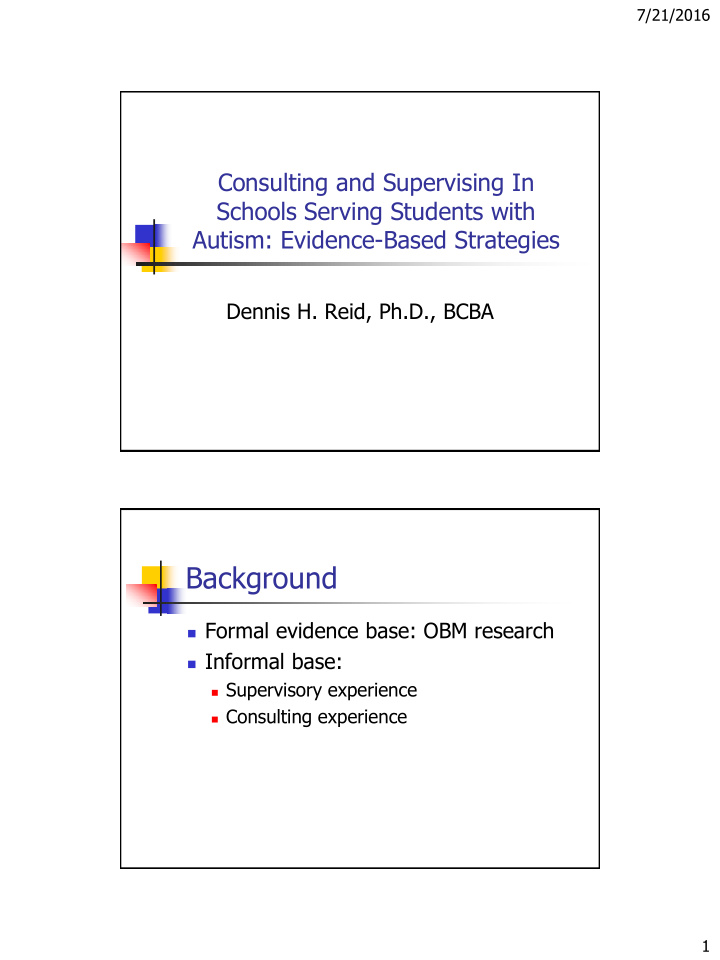



7/21/2016 Consulting and Supervising In Schools Serving Students with Autism: Evidence-Based Strategies Dennis H. Reid, Ph.D., BCBA Background Formal evidence base: OBM research Informal base: Supervisory experience Consulting experience 1
7/21/2016 Qualifications Focus on consulting From outside an agency Within an agency Not focusing on agency-wide supervisory systems Not focusing on the business end One point: > 2- way diversification Agenda Key point approach Basic premises and prerequisites Strategies Basic (technological) General (experiential) 2
7/21/2016 Common Obstacles to Consulting Premises and Prerequisites Two primary consumer groups: students and staff . . . (and of course the payer) Assume you are an aversive stimulus Know what you don’t know and acknowledge such It’s about outcomes and acceptability, not billable hours Behavior analytic consulting cannot be done from afar Know BACB ethics rules and adhere to them 3
7/21/2016 Basic Strategy 1 Always take some data For knowing what to do For evaluating your effectiveness For giving feedback To cover your backside Basic Strategy 2 Train with evidence-based procedures Performance- and competency-based or BST Formally and/or informally 4
7/21/2016 Common (Problematic) Approach to Training Staff Training Steps 1. Explain rationale 2. Describe skills 3. Provide written summary 4. Demonstrate skills 5. Trainee practice with feedback 6. Repeat #s 4 & 5 until competency 5
7/21/2016 Basic Strategy 3 Be skilled in, and practice, evidence- based feedback delivery Feedback Protocol 1. Begin with positive or empathetic statement 2. Identify skills performed correctly 3. Identify skills performed incorrectly 4. Specify how to change/improve incorrect performance 5. Solicit questions 6. Describe next actions 7. End with positive or empathetic statement 6
7/21/2016 Basic Strategy 4 Monitor acceptably Making Monitoring Acceptable Reid & Parsons (1995). Comparing choice and questionnaire measures of the acceptability of a staff training procedure. Journal of Applied Behavior Analysis, 28, 95-96. 7
7/21/2016 Making Monitoring Acceptable Greet staff upon entering work site Briefly explain reason for monitoring Use common sense re proceeding Provide feedback quickly Acknowledge staff upon departing General Strategy 1 Make job of staff as easy to do as possible (while maintaining effectiveness) With data collection With interventions 8
7/21/2016 General Strategy 2 Do what paid to do and what front-line staff want General Strategy 3 Get some quick success 9
7/21/2016 General Strategy 4 Forget about bibliotherapy (almost) General Strategy 5 Use technical language judiciously 10
7/21/2016 General Strategy 6 Know when you will likely not succeed and acknowledge such General Strategy 7 Be willing to work for more than you are paid . . . at least initially 11
7/21/2016 Reference Reid, D.H., Parsons, M.B., & Green, C.W. (2012). The supervisor’s guidebook: Evidence-based strategies for promoting work quality and enjoyment among human service staff. www.behaviordevelopmentsolutions.com Summary Use the available evidence-based technology For students For staff (training, feedback) Be very diligent Be pleasant Focus on outcome and acceptability 12
7/21/2016 Contact Denny Reid drhmc@vistatech.net 828 432 0030 13
Recommend
More recommend